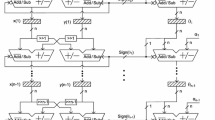Abstract
This paper presents a modified coordinate rotation digital computer (CORDIC) algorithm implemented in parallel architecture to generate sine and cosine waveform. Since CORDIC is a combination of only additions and shifts, it can be efficiently implemented in hardware. The proposed algorithm further approximates the way of computing rotation angle based on Taylor series in order to reduce the usage of Read-Only-Memory (ROM) table. Thus area and power is reduced due to partial usage of ROM storage. The precision remains the same as the original algorithm. The modified 32-bits pipeline CORDIC are implemented in Spartan XC3S500E device using Xilinx ISE 12.3 design suite. The result is compared with original CORDIC and Xilinx coregen in device utilization. It is shown that the logic usage is 31 FFs and 285 FFs less than the original design and Xilinx core, respectively. When compared with the original design, the signal power and total power reduction at 40 MHz clocks are 7.69 % and 1.35 %, respectively. The bit error remains at 10−8 dB level. The SNR of modified CORDIC is about 2 dB lower, which is acceptable in wave generation.







Similar content being viewed by others
References
S. Aggarwal, P.K. Meher, K. Khare, Scale-free hyperbolic CORDIC processor and its application to waveform generation. IEEE Trans. Circuits Syst. I, Regular Pap. 60(2), 314–326 (2012)
C.Y. Chen, Reduced ROM-based architecture for sine/cosine generator. IET Signal Process. 2(2), 118–124 (2008)
D. De Caro, N. Petra, A.G.M. Strollo, Digital synthesizer/mixer with hybrid CORDIC-multiplier architecture: error analysis and optimization. IEEE Trans. Circuits Syst. I, Regul. Pap. 56(2), 364–373 (2009)
E. Deprettere, P. Dewilde, R. Udo, Pipelined CORDIC architectures for fast VLSI filtering and array processing, in IEEE International Conference on Acoustics, Speech, and Signal Processing, vol. 9 (1984), pp. 250–253
Y.H. Hu, S. Naganathan, An angle recoding method for CORDIC algorithm implementation. IEEE Trans. Comput. 42(1), 99–102 (1993)
C. Mazenc, X. Merrheim, Computing functions arccos and arcsin using CORDIC. IEEE Trans. Comput. 42, 118–122 (1993)
P.K. Meher, S.Y. Park, CORDIC designs for fixed angle of rotation. IEEE Trans. VLSI Syst. (2013)
P. Pirsh, Architectures for Digital Signal Processing (Wiley, New York, 1998)
J.-L. Sanchez-Romero et al., Function approximation on decimal operands. Department of Computer Technology, University of Alicante, Spain
T. Srikanthan, B. Gisuthan, Optimizing scaling factor computations in flat CORDIC. J. Circuits Syst. Comput. 11(1), 17–33 (2002)
L. Vachhani, K. Sridharan, P.K. Meher, Efficient CORDIC algorithms and architectures for low area and high throughput implementation. IEEE Trans. Circuits Syst. II, Express Briefs 56(1), 61–65 (2009)
J. Valls, M. Kuhlmann, K.K. Parhi, Evaluation of CORDIC algorithms for FPGA design. J. VLSI Signal Process. Syst. Signal Image Video Technol. 32(3), 207–222 (2002)
J.E. Volder, The CORDIC trigonometric computer technique. IRE Trans. Electron. Comput. 8(3), 330–334 (1959)
J.S. Wather, A unified algorithm for elementary functions, in AFIPS Spring Joint Computer Conference (1971) pp. 379–385
C.l. Yu, A.Y. Wu, A cost-effective time-recursive FFT architecture based on improvement vector rotator for DMT transmitter. Department of Electrical Engineering, National Central University, Taiwan, ROC
Z. Zhu, Y. Liu, Z. Jin, A low-power digital processing circuit for capacitive accelerometer. Proc. Inst. Mech. Eng., Part N, J. Nanoeng. Nanosyst. 227(2), 51–55 (2013)
http://www.xilinx.com/products/intellectual-property/CORDIC.htm
Acknowledgements
This work is supported by the Fundamental Research Funds for the Central Universities (2012QNA4021) and the Zhejiang Natural Science Foundation under grant Q13F040001.
Author information
Authors and Affiliations
Corresponding author
Rights and permissions
About this article
Cite this article
Liu, Y., Fan, L. & Ma, T. A Modified CORDIC FPGA Implementation for Wave Generation. Circuits Syst Signal Process 33, 321–329 (2014). https://doi.org/10.1007/s00034-013-9638-8
Received:
Revised:
Published:
Issue Date:
DOI: https://doi.org/10.1007/s00034-013-9638-8




